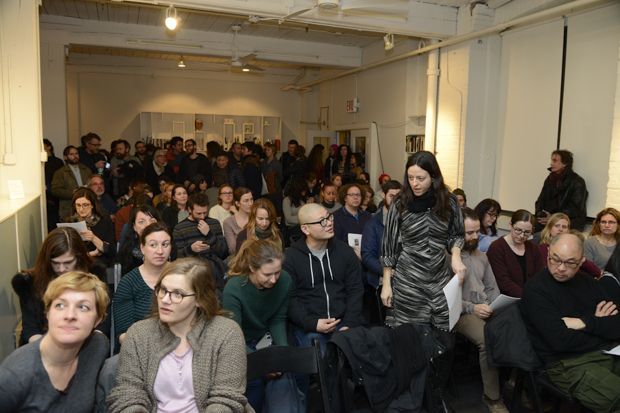What can artists do to keep their space in New York City? At last Thursday night’s panel “Studio in Crisis,” we heard ideas in the form of Williamsburg war stories, policies that don’t work, and artists who are trying experimental models. Over and over, the biggest piece of advice was “talk to your neighbors”; if we want significant change, artists will need to partner with local organizations that are already working on the problem.
Here are ten takeaways from speakers artist Jenny Dubnau, of A.S.A.P. (Artist Studio Affordability Project); Shawn Gallagher of Placeholder (formerly “Stay in Bushwick”) and the Economic Development Corporation; city planner and community organizer Tom Angotti; Brooklyn’s Deputy Borough President Diana Reyna; and audience member and member of “To Be Decided” Caroline Woolard.
- Stop making initiatives that burn out, and join community groups.
Caroline Woolard cited a census statistic that there are 93,000 artists in New York City. She pointed out that we can join forces with other working class coalitions like NYCCLI, The New York City Community Land Initiative, to make a more significant impact. She’s offered a few ideas in a document that Woolard put together with T.B.D. (“To Be Determined”)
- Join campaigns like “Real Rent Reform” and NYCCLI.
Tom Angotti: “In two years, the rent law expires. There’s already a citywide campaign, “Real Rent Reform,” talking about not only renewing the rent regulation but strengthening it. It needs a lot of work. I would urge everybody to join that campaign, I think it’s very important.”
- The Loft Law doesn’t help new artists.
“Make no mistake that the Loft Law does now benefit anyone other than the property owner,” said Diana Reyna. Reyna believes that the 1982 Loft Law, which protects previously-illegal tenants with basic residential rights, only opens properties up to speculators. An audience member disagreed, saying that there are several artists living in lofts in Soho. “We are not in Soho,” Caroline Woolard later pointed out.
Diana Reyna believes that the Loft Law will only work if we keep track of loft properties. There is currently no public database for this.
- Communities can make their own development plans.
According to Tom Angotti, a 1989 revision to the New York City charter allows people to present their own development plans to the City Planning Department for approval. While the plans can be approved, however, the city makes no commitment to implement those plans; this policy was especially fruitless during the Bloomberg years, when Angotti says that community development plans were largely tossed in the trash. Angotti sees the change of administration as a new opportunity for communities to re-assert this right
- Talk to your neighbors.
“If you say it’s inevitable, there’s nothing I can do, then you’re finished, and your neighbors are finished,” Tom Angotti said. Read Angotti’s “Five Things You Can Do About Gentrification.”
- Get appointed to a community board.
Diana Reyna suggested that artists get involved with local communities to change how artists are still “seen as the enemy” in Bushwick. Deborah Brown provides a notable example of an artist now serving on a community board in Bushwick.
- Join other groups to lobby Albany to repeal the Urstadt Law.
The Urstadt Law was enacted in 1971 as part of Rockefeller’s vacancy-decontrol legislation, and it gives the control of New York City rent laws to the state, not the city government. This needs to change so that the local legislature has the power to address local housing conditions.
- Should artists be considered middle class small business owners? Or working class wage earners?
Paddy wondered whether talking about ourselves as middle-class business owners would help artists to get more legal protections. “Maybe we’re employing framers, other manufacturers…but our special needs are specific to our business, which falls under a larger constituency.”
Jenny Dubnau noted that there are some commercial rent stabilization benefits available to small manufacturers. However, Shawn Gallagher says the metrics to give out the benefits (job creation, taxes) don’t really apply to artist studios.
Later, an audience member also pointed out that most of us aren’t anywhere near a small manufacturer’s pay grade.
- How feasible is the idea of buying a property and renting it out to our friends?
“One of the greatest hurdles our group has come up against is how do you secure the funding too purchase a building, build it our, renovate it, and get it up and running as artist studios?” Shawn Gallagher said when discussing Placeholder (formerly, “Stay in Bushwick”). “The classic four-story warehouse building…is almost unattainably expensive. You’re talking tens of millions of dollars.”
Placeholder, a collective group which includes members William Powhida, Jules de Ballincourt, Shawn Gallagher, Lynn Sullivan, Paddy Johnson, Nicholas O’Brien, and Caitlin Bright hopes to buy a building and permanently devalue the property with a restrictive covenant.
- A community land trust would be best for everybody.
“ It would be nice if everybody owns their own space, but how do I know you’re not going to become speculators and just contribute to the problem?” said Tom Angotti. “I think the real question is, who owns the land, and can you keep the land prices down? That’s why restrictive covenants or community land trusts are really critical, because everybody can own their own space but they can’t speculate.”
Angotti also talked about what the city could do to further land trusts. “It would help enormously if there were a change in city policy,” he said. “When Bernie Sanders was mayor of Burlington, VT, he said “We’re going to take our federal HUD money, and every time we invest in a building, it’s going to go into a land trust. So all of the subsidized units in Burlington are in land trusts, it’s one of the largest land trusts in the country. That’s what we could do. New York City hasn’t done that.



Comments on this entry are closed.